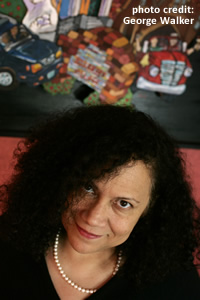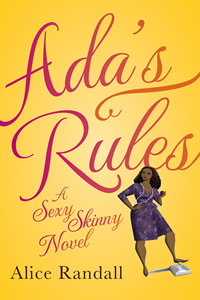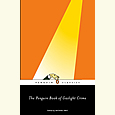Weight Lost and Love Found
Alice Randall’s novel romantic comedy tells the story of a Nashville woman’s renewed appetite for life
The title of Alice Randall’s novel-cum-diet book, Ada’s Rules, refers to the protagonist’s “perfect rules for an imperfect but excellent health and beauty revival.” When Ada Howard opens an invitation to her twenty-fifth college reunion, a year away, she is moved to step on a scale for the first time in as long as she can remember. Shocked to find that she’s ballooned to 220 pounds and inspired by the prospect of bumping into her former boyfriend, the five-foot-two-inch Ada sets out on a quest to shed a hundred pounds in twelve months. She starts by writing a list of fifty-three rules. Number one on the list: “Don’t keep doing what you’ve always been doing.”
Randall is a Harvard-educated African American who writes country songs. (Most famously, she co-wrote Trisha Yearwood’s “Xxx’s and Ooo’s (An American Girl).”) She is also the author of three prior novels (The Wind Done Gone, Pushkin and the Queen of Spades, and Rebel Yell) and Writer-in-Residence at Vanderbilt University in Nashville. And in addition to all that, she’s a food activist who believes that “health disparity is the dominant civil rights issue of the first quarter of the 21st century.” Perhaps unsurprisingly, given her wide-ranging interests and experience, Randall’s latest book defies categorization. It’s like a literary set of Russian nesting dolls: a self-help book tucked inside a larger, fictional story that clicks together snugly. Randall’s gift for lyricism is one key to the success of Ada’s Rules; the others include the easy flow of Ada’s storytelling, her candid voice, and the book’s true-to-life comedic romance.
 Ada Howard is married to the pastor of Nashville’s Full Love Gospel Tabernacle, and her motivation to slim down stems not only from an unresolved interest in her college sweetheart but also from a growing suspicion that her husband of more than two decades, Lucius “Preach” Howard, is having an affair. She has no proof, but he has recently bought a new car, lost weight, and cut his hair. Already absent much of the time, Preach now wants to have a shower installed in his office at the church. And Ada has overheard nosy but mostly well-meaning church congregants gossiping about both her own obesity and her husband’s desirability. Unable to remember the last time they had sex, Ada’s determined “to create a feast that would bring her husband back to the table of her body.”
Ada Howard is married to the pastor of Nashville’s Full Love Gospel Tabernacle, and her motivation to slim down stems not only from an unresolved interest in her college sweetheart but also from a growing suspicion that her husband of more than two decades, Lucius “Preach” Howard, is having an affair. She has no proof, but he has recently bought a new car, lost weight, and cut his hair. Already absent much of the time, Preach now wants to have a shower installed in his office at the church. And Ada has overheard nosy but mostly well-meaning church congregants gossiping about both her own obesity and her husband’s desirability. Unable to remember the last time they had sex, Ada’s determined “to create a feast that would bring her husband back to the table of her body.”
This may sound like the predictable story of a woman trying to attract male attention, but Randall adds depth and context by making Ada a multi-dimensional character and by including side stories about relationships of all kinds. There’s Ada’s role of caregiver to her aging, whiskey- and marijuana-dependent parents, who often don’t recognize her. There’s Ada’s grief for her three older sisters, each of whom died by age sixty. There’s Ada’s close relationships with her voluptuous, twenty-something twin daughters. The more focused Ada becomes on losing weight and getting into shape, the more ardently she wants her daughters to do the same, to have a healthy future and to live fully in their bodies.
In her work running a children’s daycare center, Ada faces parental resistance to celebrating birthdays without cupcake binges, but she is determined to challenge the common view (which she has always shared) that rich food signifies love and tradition. “I don’t know why you young people insist on thinking of fried chicken and Kool-Aid and God knows what else as soul food,” an older woman admonishes her at the grocery store. “Soul food may be chicken once a month when the preacher comes, but it ain’t fried chicken every day. And it’s not anything made with corn syrup or wheat flour. And it ain’t butter neither.” The woman suggests a diet of baked sweet potatoes and spoonfuls of peanut butter.
 The characters who appear in Ada’s Rules are so varied it can be hard to keep them straight or to recognize which ones are most important. Ada’s best and oldest friend, for instance, isn’t mentioned until page 235. When Delila does at last appear, it’s with a bang: over breakfast at the Pancake Pantry, she recommends that Ada go shopping at Rebecka Vaughan, a lingerie shop in Green Hills. “Honey,” Delila announces, “women who don’t know nothing about men think it’s the clothes you wear that makes them want you.” Instead, she says, it’s “a woman’s smile and her underwear.” (This particular observation is a G-rated, but Ada’s Rules doesn’t shy away from descriptions of naked bodies, grooming rituals, and sex.)
The characters who appear in Ada’s Rules are so varied it can be hard to keep them straight or to recognize which ones are most important. Ada’s best and oldest friend, for instance, isn’t mentioned until page 235. When Delila does at last appear, it’s with a bang: over breakfast at the Pancake Pantry, she recommends that Ada go shopping at Rebecka Vaughan, a lingerie shop in Green Hills. “Honey,” Delila announces, “women who don’t know nothing about men think it’s the clothes you wear that makes them want you.” Instead, she says, it’s “a woman’s smile and her underwear.” (This particular observation is a G-rated, but Ada’s Rules doesn’t shy away from descriptions of naked bodies, grooming rituals, and sex.)
Ada follows her doctor’s advice to drink eight glasses of water, sleep eight hours a night, and walk thirty minutes a day, every day, but at its heart, the story of Ada’s weight loss is the story of rediscovering happiness. After years dedicated to taking care of other people, Ada finally begins to pay attention to herself. Over the course of the year, Ada’s weight-loss tactics include having her DNA tested to determine the ideal diet, massaging her own feet, and making a ritual out of drinking herbal tea while taking a bubble bath and listening to music. Steadily, the pounds come off. On her fiftieth birthday, at 150 pounds, Ada eats two plums for breakfast and spends the afternoon jumping rope and laughing out loud. Somewhere between the story’s beginning and its end, Ada builds herself a bigger, richer, more satisfying life.
Breezy and humorous, Ada’s Rules will appeal to fans of light contemporary fiction as well as to those interested in losing weight themselves. “If you want to be skinny easy,” Ada writes in the preface to her book of rules, “pick skinny parents. If you can’t pick skinny parents, read my book. And if you picked skinny parents and you want to stay skinny in this new fat world—read my book.”
Alice Randall will discuss Ada’s Rules at Parnassus Books in Nashville on May 8 at 6:30 p.m. and at Barnes & Noble at Vanderbilt University on May 19 at 2 p.m.


